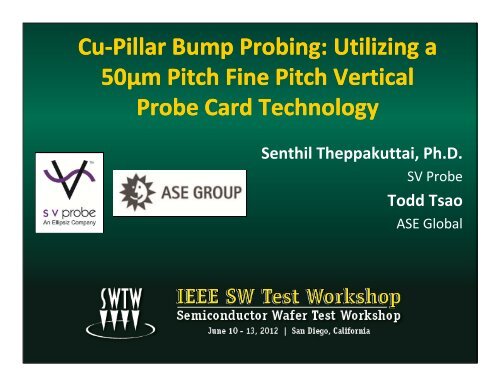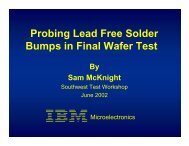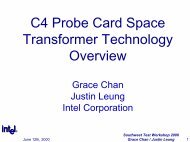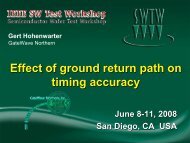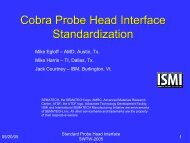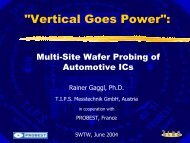Cu-Pillar Bump Probing: Utilizing a 50µm Pitch Fine Pitch Vertical ...
Cu-Pillar Bump Probing: Utilizing a 50µm Pitch Fine Pitch Vertical ...
Cu-Pillar Bump Probing: Utilizing a 50µm Pitch Fine Pitch Vertical ...
You also want an ePaper? Increase the reach of your titles
YUMPU automatically turns print PDFs into web optimized ePapers that Google loves.
<strong>Cu</strong>‐<strong>Pillar</strong> <strong>Bump</strong> <strong>Probing</strong>: <strong>Utilizing</strong> a<br />
50µm <strong>Pitch</strong> <strong>Fine</strong> <strong>Pitch</strong> <strong>Vertical</strong><br />
Probe Card Technology<br />
Senthil Theppakuttai, Ph.D.<br />
SV Probe<br />
Todd Tsao<br />
ASE Global
Outline<br />
• Introduction to <strong>Fine</strong> <strong>Pitch</strong> Copper <strong>Pillar</strong> <strong>Bump</strong>s<br />
• Testing/<strong>Probing</strong> Requirements<br />
• Test Vehicle Design<br />
• Probe Card Challenges<br />
• Test Data<br />
• Summary<br />
2
Introduction<br />
• Next Generation Flip Chip Interconnects<br />
–2.5, 3D Integration Process<br />
• Electroplated Copper <strong>Pillar</strong>s with Solder Caps<br />
• Advantages<br />
–<strong>Fine</strong> <strong>Pitch</strong> Capability<br />
– Increased I/O Density<br />
–Improved Electrical & Thermal Performance<br />
• Superior Electro‐Migration<br />
– Higher Reliability at Lower Cost<br />
3
Copper pillar/post<br />
(< 50 um pitch)<br />
Memory<br />
Processor<br />
4
Testing/<strong>Probing</strong> challenges<br />
• Probe Card Requirements<br />
–P/C Required at 50µm & Below in Array<br />
Configuration<br />
–Small <strong>Bump</strong> Diameter<br />
• Need Very Low <strong>Probing</strong> Force<br />
• Need Very Good Tip Alignment<br />
– Need Probe Compliance to Accommodate <strong>Bump</strong> to<br />
<strong>Bump</strong> Variation Across Wafer<br />
5
Goals/Objective<br />
• Evaluation Objective/Scope<br />
–Probe Card Feasibility at 50µm Array<br />
– Copper <strong>Pillar</strong> <strong>Bump</strong> <strong>Probing</strong> Evaluation<br />
•<strong>Bump</strong> Damage Assessment<br />
• Electrical, Thermal & Mechanical Characterization<br />
• Test Equipment<br />
–Test Chip by ASE<br />
–LT50 Probe Card by SV Probe<br />
–P‐12 XLn Prober, HP93000 Tester<br />
– Microscope, SEM, Veeco Profilometer<br />
6
Prober<br />
Equipment Utilized<br />
Tester<br />
Docking<br />
SEM<br />
Veeco<br />
7
Test Chip Design<br />
• Test Chip Design Details<br />
– 50µm <strong>Pitch</strong><br />
– Array Configuration, 4 Groups, 500 Points Total<br />
– Daisy‐chain Resistance Measurement<br />
Array Layout<br />
Optical Picture<br />
8
<strong>Cu</strong>‐<strong>Pillar</strong> Structure<br />
25µm<br />
Side View<br />
Solder <strong>Bump</strong><br />
<strong>Cu</strong>‐<strong>Pillar</strong><br />
25µm<br />
Initial <strong>Bump</strong> Height : ~25 +/‐3µm<br />
9
LogicTouch TM <strong>Vertical</strong> <strong>Probing</strong> Technology<br />
3<br />
2<br />
1. Probes / PH<br />
2. Space Transformer<br />
3. PCB<br />
1<br />
– Technology Capable of <strong>Probing</strong> 50µm Arrays<br />
– Technology Scalable to 40µm <strong>Pitch</strong><br />
10
PROBE CARD CHALLENGES<br />
11
Scalability Challenges<br />
• Space Transformer Availability at 50µm <strong>Pitch</strong> Array<br />
–Based on Standard Thin Film Technology Capability, Difficult to<br />
Achieve Escapement Required for Routing<br />
– Need Pad on Via at <strong>Pitch</strong> & Hence MLC/MLO not Feasible for<br />
Array Configurations at 50µm <strong>Pitch</strong><br />
–New Type of Interconnect was Developed Internally –the<br />
Modular Space Transformer or MST TM PH<br />
MST<br />
PCB<br />
12
Scalability Challenges<br />
• Guide Plate Wall Strength<br />
– Reduced Wall Strength due to Reduced Wall Thickness due to<br />
the Spatial Constraints at 50µm <strong>Pitch</strong><br />
–Probes Designed to Minimize Loading on Guide Plate (FEA)<br />
– Stress/Life Tests at Max OT to Ensure Wall Integrity<br />
Guide Plate<br />
13
Guide Plate Reflectivity<br />
• The MEMS Guide‐plates Used in LT50 Probe Cards have<br />
a Smooth & Polished Surface Finish<br />
– Lighting Adjustments may be Required During Probe Card<br />
Setup at PCA & Prober<br />
• Various Anti‐reflective Surface Treatments were<br />
Evaluated to Reduce Normal Reflection<br />
– Surface Scattering (Textured/Engineered Surface)<br />
– Interference (Thin Films/Coatings)<br />
Veeco Reflectivity Measurement<br />
P‐12 Prober<br />
Control<br />
Sample<br />
AR<br />
Surface<br />
P‐12 Prober Pictures: High Mag, Light Level 120, Focused 7‐8 mils above Die Surface<br />
14
PROBE CARD DATA<br />
15
Probe Force<br />
• Contact Force of 2.5 gf @ 50µm OT<br />
• Preferred <strong>Bump</strong> <strong>Probing</strong> OT 25 to 40µm<br />
– Minimize <strong>Bump</strong> Damage<br />
– Accommodate <strong>Bump</strong> Co‐planarity Across Wafer<br />
16
Tip Alignment<br />
• Probe Tip Alignment –0.3 mil Radial<br />
17
Planarity<br />
• Probe Planarity < 0.5 mil (12µm)<br />
18
Resistance on Gold<br />
• Max Total Resistance is 3.2 Ohms (includes Cres<br />
& Path Resistance through PH, ST & PCB)<br />
19
COPPER PILLAR BUMP PROBING<br />
20
Test Method<br />
In<br />
Out<br />
25µm<br />
25 µm<br />
25µm<br />
Si<br />
Daisy Chain <strong>Bump</strong> Structure
Probe Mark<br />
Before Contact<br />
After Contact<br />
*Over‐Drive: 40µm<br />
# probing: 2 TDs<br />
Probe Mark Area Under 30%
• Electrical Tests<br />
Tests in Process<br />
–Cres, Leakage Characterization vs. OT, # TD<br />
• Mechanical<br />
–Probe Mark Size Characterization vs. OT, # TD<br />
–<strong>Bump</strong> Damage Assessment vs. OT, # TD<br />
• Thermal<br />
–Effect of Temperature (Hot, Room & Cold) on:<br />
•Probe Card Performance (e.g. Cres Stability, Cleaning etc.)<br />
•Probe Mark / <strong>Bump</strong> Damage<br />
23
Summary / Conclusion<br />
• To Address Test Challenges Associated with <strong>Fine</strong> <strong>Pitch</strong> Copper<br />
<strong>Pillar</strong> <strong>Bump</strong> <strong>Probing</strong><br />
– A Test Chip with 25µm <strong>Pillar</strong> <strong>Bump</strong>s at 50µm <strong>Pitch</strong> Array was Designed &<br />
Fabricated<br />
– An LT50 Probe Card at 50µm <strong>Pitch</strong> Array was Designed & Built with SV<br />
Probe’s Proprietary ST Technology<br />
• Test / Evaluation<br />
– Probe Card Feasibility at 50µm Array Verified<br />
– Good Probe Card Tip Alignment & Planarity<br />
– Max Total Resistance through P/C was 3.2 Ohms, avg 1.7 Ohms<br />
– P/C Passed Opens/Continuity Test on Copper <strong>Pillar</strong> <strong>Bump</strong>s<br />
– Probe Mark was < 30% of <strong>Bump</strong> Area at 40µm OT at 2 TDs<br />
• Successful Collaboration between ASE & SV Probe & the<br />
Preliminary Evaluation Results to Date have been Positive<br />
24


